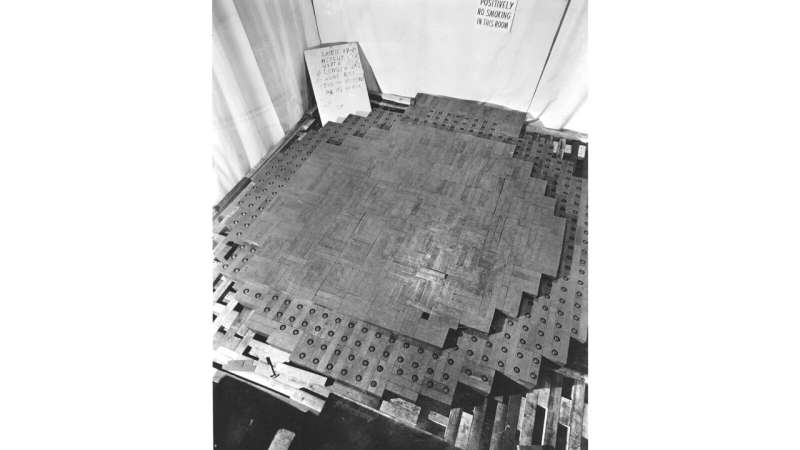Chicago Pile 1: A bold nuclear physics experiment with enduring impact

An unassuming pile of black graphite bricks containing uranium became known famously as Chicago Pile 1, the world's first human-created, self-sustaining nuclear chain reaction. Eighty years later, nuclear scientists continue to deliver on its promise.
On a frigid Dec. 2, 1942, beneath The University of Chicago's football field, Enrico Fermi and his colleagues conducted a physics experiment that forever changed the world. An all-important step forward for the United States in its Manhattan Project race to outwit Germany in the pursuit of atomic weapons, the secretive Chicago Pile 1 experiment hastened the end of World War II. It also opened the door to medical isotopes that treat cancer, neutrons for materials science experiments, and safe, renewable nuclear energy. Today, that energy powers everything from submarine fleets to homes and businesses without adding any carbon to the atmosphere.
Fermi's experiment was at once complex and simple. A 20-feet wide by 25-feet high pile of graphite bricks included a few that contained small amounts of uranium. Long, vertical, wooden rods coated in cadmium, a material known to slow the movement of neutrons, laced the pile. By methodically removing the rods, Fermi and his team proved that atoms in the uranium's nucleus could be triggered to split. Some of the neutrons ejected from the original atoms were absorbed by other uranium atoms, safely releasing energy each time until the scientists slowed the chain reaction to a stop by carefully reinserting the rods.
Considered a major success, the experiment was nicknamed CP-1. It produced enough energy to power one small lightbulb. Now, nuclear power fuels almost 20% of electricity used in the U.S. and most U.S. submarines. Approximately half of the country's renewable electricity is provided by nuclear power. Other countries rely on the technology for clean power too.
It is appropriate that an experiment so reliant on graphite, the material found in common pencils, continues to write history. CP-1's success spelled the end of a world war for one generation and inspired formation of a national laboratory system that has benefitted every generation since.
The first, U.S. Department of Energy's Argonne National Laboratory, was chartered in 1946. Sixteen others followed, creating a powerful network of research and development focused initially on nuclear energy but ultimately on many other areas of science as well.
Today, Argonne uses its rich historical knowledge of and experience in nuclear energy to address other urgent issues, such as climate change, renewable energy, a stable infrastructure and national security.
"Argonne's story began with the Chicago Pile 1 experiment but it's exciting that today's nuclear scientists and engineers are looking ahead to new designs and technologies," said Argonne principal nuclear engineer Roger Blomquist.
New nuclear designs build on history
Nuclear reactor design has come a long way since Fermi's pile and wooden control rods. There are light-water reactors, boiling water reactors, sodium-cooled reactors, advanced fast reactors and more.
There are plans for advanced fast microreactors that can be built in one facility and shipped elsewhere for conjoining. Such reactors would be useful for powering remote or artic regions and securing military encampments. They may even someday be ready for shipment to interstate fueling stations, where they have been proposed for use recharging battery-powered long-haul semitrucks. Advanced reactors can be used for industrial heat applications that will help decarbonize industry; water-cooled reactors can be used for heat to cut use of natural gas.
Notably, Argonne's newer designs of advanced fast reactors have the ability to increase the amount of energy extracted from uranium by a factor of 100. This means they significantly reduce how much used nuclear fuel remains after power generation and how long the used nuclear fuel remains hazardous.
Advances in the safety of nuclear reactors have been lockstep with Argonne reactor design every step of the way. For example, the laboratory successfully tested inherent safety—the idea that a reactor could cool itself using its own physics—during a simulated accident scenario at its Experimental Breeder Reactor-II research reactor in the 1980s. The important findings helped Japan during and after the Fukushima I power plant emergency of 2011. Argonne has also partnered for decades with the National Nuclear Security Administration to improve the security and safety of enriched uranium and research reactors worldwide.
Argonne's high performance computing resources also make it possible for scientists to significantly accelerate the complex physics calculations Fermi and his team performed manually. Artificial intelligence and high-fidelity models and simulations allow engineers to create digital twins of reactor cores before they ever attempt to construct real ones. The technologies and software Argonne develops for nuclear reactors are shared with industry so that all nuclear designs benefit from the fundamental understanding of physics pioneered by Fermi and colleagues and developed over decades by the national laboratories.
"Argonne has conducted thousands and thousands of experiments, and we analyze them with the same computer software we use to design new reactors," said Blomquist. "In this way, we tie computer-based designs to actual physics. Whether it's Argonne or small, innovating companies, we all benefit."
Combined, these improvements result in clean, safe energy that is increasingly cost-effective. Eighty years after Fermi's ground-breaking experiment, peaceable nuclear energy is poised for its next great moment.

















